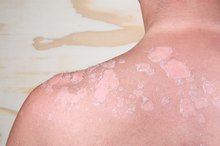Rashlike Pigmentation on the Foot
Certain rashlike pigmentations on the foot are merely aesthetic concerns and pose no particular health risks. Other types of pigmentations or rashes are serious and need immediate medical attention. Do not attempt self-diagnosis for any type of skin rash or unusual pigmentation.
Diabetic Dermopathy
Diabetes weakens blood vessels and capillaries. Broken capillaries create a splotchy, rashlike appearance. This condition is called diabetes dermopathy. Dermopathy can occur on the lower legs as well as the feet. Diabetes dermopathy is not usually a serious condition and does not require medical intervention, although improved blood glucose control can prevent or reduce symptoms, according to DermNet NZ. If rashlike pigmentation or any other unusual symptoms appear on your feet, consult your medical provider for diagnosis.
- Diabetes weakens blood vessels and capillaries.
- If rashlike pigmentation or any other unusual symptoms appear on your feet, consult your medical provider for diagnosis.
Venous Stasis
Brown Spots on the Legs of a Diabetic
Learn More
A condition known as venous stasis dermatitis can cause a reddish-brown pigmentation in the skin of the lower extremities, according to PodiatryNetwork.com 2. When veins lose elasticity and impair circulation, tiny blood vessels may break and leak hemoglobin subcutaneously. Iron molecules from the hemoglobin can stain the skin, giving the appearance of brown pigmentation in a freckle-type pattern. Unless the condition causing the circulation problem is addressed, venous stasis dermatitis can progress to a more serious condition known as venous stasis ulceration.
- A condition known as venous stasis dermatitis can cause a reddish-brown pigmentation in the skin of the lower extremities, according to PodiatryNetwork.com 2.
- Iron molecules from the hemoglobin can stain the skin, giving the appearance of brown pigmentation in a freckle-type pattern.
Cancer
Writing on her website, Dr. Angela Drury, DPM, FACFAS states that pigmentations on the feet are usually moles or freckles, but pigmentations may be cancerous lesions. Examination by a podiatrist or dermatologist is recommended. According to Drury, two types of skin cancer can occur on the foot: melanoma and the precancerous condition actinic keratosis. Melanoma can appear anywhere on the feet, even under the toenails. Actinic keratosis is often mistaken for plantar warts. Treatment for either one of these conditions is by freezing with liquid nitrogen or surgical removal.
- Writing on her website, Dr. Angela Drury, DPM, FACFAS states that pigmentations on the feet are usually moles or freckles, but pigmentations may be cancerous lesions.
- According to Drury, two types of skin cancer can occur on the foot: melanoma and the precancerous condition actinic keratosis.
Age Spots
What Is the Difference Between Stasis Dermatitis & Cellulitis?
Learn More
Brown pigmented areas can appear on parts of the body most often exposed to the sun, including the feet. These pigmented areas are called age spots. Although they are not directly related to the aging process, they do more often appear in older people because of the accumulation of sun damage over time. According to MayoClinic.com, age spots can range in size from freckle-like to more than 1/2 inch in diameter. At times these spots occur in clusters, making them more prominent. Spots and lesions should be examined by a medical physician to rule out cancer or other serious conditions, MayoClinic.com advises.
- Brown pigmented areas can appear on parts of the body most often exposed to the sun, including the feet.
- According to MayoClinic.com, age spots can range in size from freckle-like to more than 1/2 inch in diameter.
Related Articles
References
Writer Bio
For Judy Kilpatrick, gardening is the best mental health therapy of all. Combining her interests in both of these fields, Kilpatrick is a professional flower grower and a practicing, licensed mental health therapist. A graduate of East Carolina University, Kilpatrick writes for national and regional publications.








